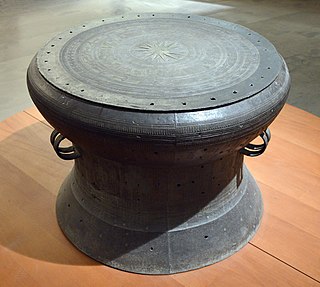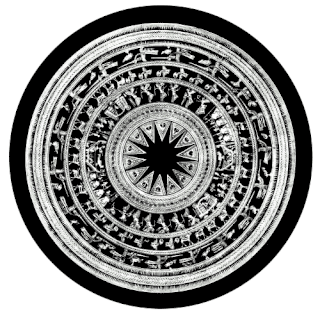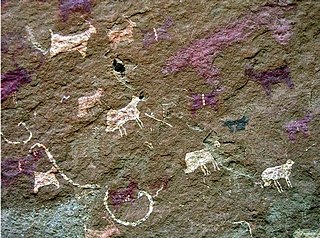
Áo dài is a modernized Vietnamese national garment consisting of a long split tunic worn over silk trousers. It can serve as formalwear for both men and women. Áo translates as shirt and dài means "long". The term can also be used to describe any clothing attire that consists of a long tunic, such as nhật bình.

The culture of Vietnam are the customs and traditions of the Kinh people and the other ethnic groups of Vietnam. Vietnam is part of Southeast Asia and the Sinosphere due to the influence of Chinese culture on Vietnamese culture.

A headband or hairband is a clothing accessory worn in the hair or around the forehead, usually to hold hair away from the face or eyes. Headbands generally consist of a loop of elastic material or a horseshoe-shaped piece of flexible plastic or metal. They come in assorted shapes and sizes and are used for both fashion and practical or utilitarian purposes.

The 2003 Southeast Asian Games, officially known as the 22nd Southeast Asian Games, SEA Games 22 and also known as Vietnam 2003, was a Southeast Asian multi-sport event held from 5 to 13 December 2003 in Hanoi, Vietnam. This was the first time that Vietnam had staged the SEA Games, and it saw East Timor, which had just gained independence in 2002; although not being an ASEAN member and despite its geographical location closer to the Pacific archipelago than the Asian continent, making its debut at the games.

Vietnamese clothing is the traditional style of clothing worn in Vietnam by the Vietnamese people. The traditional style has both indigenous and foreign elements due to the diverse cultural exchanges during the history of Vietnam. This all eventually led to the birth of a distinctive Vietnamese style of clothing, including the birth of the unofficial national dress of Vietnam, the áo dài.

Cổ Loa Citadel is an important fortified settlement and archaeological site in present-day Hanoi's Đông Anh district, roughly 17 kilometers north of present-day Hanoi, in the upper plain north of the Red River. Various relics of the Bronze Age Phùng Nguyên culture and Đông Sơn culture have been found in Cổ Loa, although it was later established as the capital of Âu Lạc Kingdom during the 3rd century BCE. It might be the first political center of the Vietnamese civilization. The settlement’s concentric walls resemble a snail’s shell; it had an outer embankment covering 600 hectares.

A Đông Sơn drum is a type of ancient bronze drum created by the Đông Sơn culture that existed in the Red River Delta. The drums were produced from about 600 BCE or earlier until the third century CE; they are one of the culture's most astounding examples of ancient metalworking. The drums, cast in bronze using the lost-wax casting method are up to a meter in height and weigh up to 100 kilograms (220 lb). Đông Sơn drums were apparently both musical instruments and objects of worship.

Vietnamese art is visual art that, whether ancient or modern, originated in or is practiced in Vietnam or by Vietnamese artists.

Bronze drums are ancient artifacts found in various cultures in Southeast Asia and southern China. The drums were cast in bronze using the lost-wax casting method. The drums were both musical instruments and cult objects. They are decorated with geometric patterns, scenes of daily life and war, animals and birds, and boats. Bronze drum is considered as one of the national symbols of Vietnam.

Việt Khê is an archaeological site in the Red River Delta in northern Vietnam. Excavations there yielded a number of coffins containing relics of the Dong Son culture in Bronze Age. The Việt Khê construction site is located on the southern base of a hill which overlooks the Hàn River near Thủy Nguyên District, Haiphong. Five wooden coffins were excavated in 1961, each of which were aligned in the east-west direction, with at least two pairs of coffins being configured in a linear manner.
Xuân La is an archaeological site in Tây Hồ District of Hanoi, near ancient Hà Đông in the Red River Delta in northern Vietnam. Excavations there yielded a number of coffins containing relics of the Bronze Age Đông Sơn culture.
Châu Can is an archaeological site in the Red River Delta in northern Vietnam. It was located in Hà Sơn Bình province when it was excavated in 1974, but in 1975 was reorganized into Hà Tây province. Excavations there yielded a number of coffins containing relics of the Bronze Age Đông Sơn culture.

Trần Thu Hà, also known as Hà Trần is a Vietnamese singer and producer. She is considered by the public and critics as one of the four divas in Vietnam, alongside Thanh Lam, Hồng Nhung, and Mỹ Linh.

Vietnamese architecture is the architectural style used by the Vietnamese through the process of historical development and the absorption and integration of regional and international architectures. Vietnamese architecture is reflected in the works from đình, shrines, temples, nhà thờ họ, citadels, palaces and housing architecture.

Headgear, headwear, or headdress is any element of clothing which is worn on one's head, including hats, helmets, turbans and many other types. Headgear is worn for many purposes, including protection against the elements, decoration, or for religious or cultural reasons, including social conventions.

Dhambalin is an archaeological site in the central Sahil province of Somaliland. The sandstone rock shelter contains rock art depicting various animals such as horned cattle and goats, as well as giraffes, an animal no longer found in the country. The site also features the earliest known pictures of sheep in Somaliland. Discovered in autumn 2007, residents of Beenyo Dhaadheer reported the rock art to the Somali archaeologist Sada Mire, Director of the Department of Archaeology within the Ministry of Tourism and Culture of Somaliland.

The áo giao lĩnh, referred to as the giao lãnh y in Literary Chinese texts. Folk often call it áo tràng vạt or áo tràng xiên, referred to as áo tràng, was a traditional cross-collared robe worn by Vietnamese before the 19th century. It was influenced from Han Chinese clothing and was typically worn by the royalty, the aristocracy, the nobility, and the commoners. During the Nguyễn dynasty, the áo ngũ thân was commonly worn and the áo giao lĩnh was only worn in formal occasions.
Beopgonori (Korean: 법고놀이) is a type of traditional Korean performance. In the performance, a drummer plays the beopgo, a small drum, while dancing. The name beopgo originally refers to one of the four Buddhist instruments. In the late Joseon period, Buddhist monks often went about asking for alms with a dharma drum set up on the roadside or formed a nongak band and begged for rice. These monks were called beopgo monks or gutjungpae, meaning a group of monks who played percussion music to raise money.

An Son is a mounded archaeological site located in the An Ninh Tay commune of the Đức Hòa district along the Vam Co Dong River in Long An province, Southern Vietnam. The site was originally discovered in 1938 by Louis Malleret and Paul Levy. Multiple excavations over a period of six decades have revealed that An Son was continuously occupied during the Neolithic period between approximately 2300-1200 B.C. During the excavations, archaeologists found many artifacts indicative of a Neolithic lifestyle similar to other Neolithic sites in Southern Vietnam and Thailand. Excavations have found pottery as well as ceramic productions. Furthermore, the burials found from excavations at An Son have gathered evidence of ritual ceremonies, an indication of the belief system of this area.

A Tam quan or Tam môn is a style of traditional gateway symbolic of Vietnamese Buddhism. It has three aisles. Not only are they applied in Buddhist works, they are also commonly applied to other religious works such as Confucianism, Taoism, Vietnamese folk religion and Christianity. They are also applied to non-religious modern buildings such as schools and People's committee buildings.


















